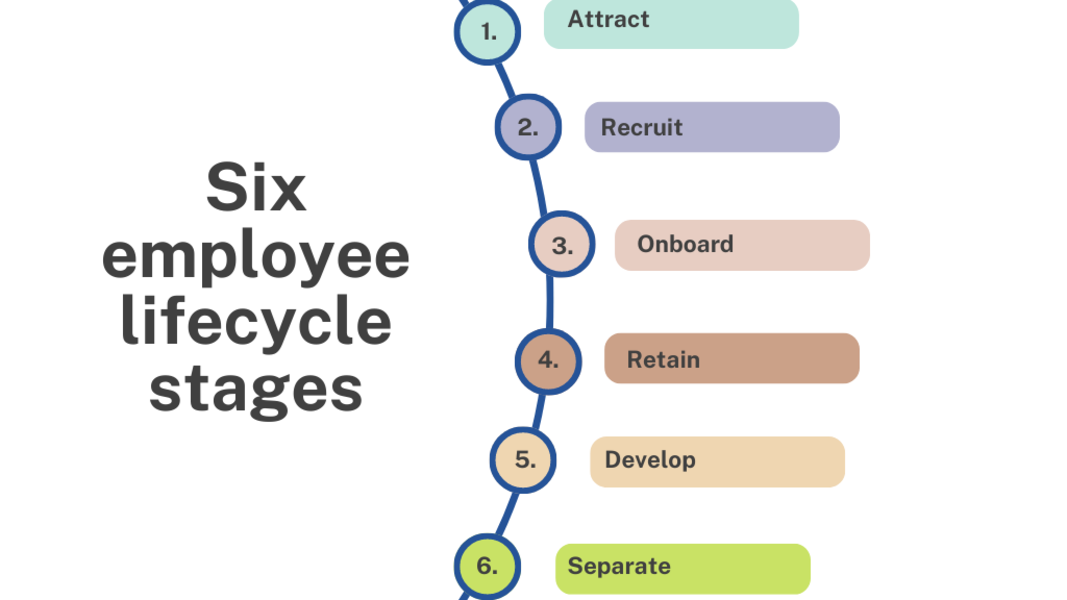
What Is The Employee Life Cycle – And Why Is It Important?
December 12, 2022

What are the 6 Stages of the Employee Life Cycle?
The employee lifecycle describes the journey of employees, from pre-employment through termination, and outlines how companies can use each stage to improve organizational performance.
The six stages of the employee life cycle are:
- Attraction
- Recruitment
- Onboarding
- Retention
- Development
- Separation
Stage 1: Attraction
Attraction is an important component of the employee life cycle. It's a process that helps organizations to identify, attract and select individuals with the necessary skills, knowledge, abilities and qualifications for a specific job.
Attraction is typically associated with recruitment but it's much broader than that. Attraction begins long before recruiting even starts and can be used to build relationships with potential candidates in order to create an applicant pool of qualified individuals who may be interested in working for an organization.
The attraction process includes activities such as developing a brand strategy and creating a positive employer image. This helps organizations attract higher-quality candidates by positioning themselves as employers of choice through marketing initiatives like social media campaigns or attending recruitment fairs. Additionally, organizations must ensure they have competitive employment packages in place to appeal to potential employees.
Stage 2: Recruitment
Recruitment is a crucial step in the employee life cycle. It is the process of sourcing, screening, and hiring qualified candidates to fill roles within an organization. By having an effective recruitment process, organizations are able to establish a talented workforce that will serve as the foundation for the company's success.
Recruitment begins with identifying and defining job roles within an organization. Developing skills profiles for each role helps to gain clarity on which type of individuals should be recruited for a given position. It also helps to create criteria for selecting suitable candidates who can bring unique perspectives and knowledge to the table.
After a list of potential applicants has been identified, employers may utilize interviews and assessments to find out more about each candidate's abilities and experience while learning if they would be well suited for their open roles.
Stage 3: Onboarding
Onboarding sets the tone for the entire relationship between employer and employee. It should be approached with care as it will shape the entire work experience for each individual hire.
During this process, employers can establish expectations, provide guidance on company policies and procedures, ensure that employees have access to necessary resources, and foster a feeling of inclusion within their organization's culture.
It involves orienting, training, and integrating new employees into a company's culture. Onboarding is crucial for ensuring that new hires have all the tools they need to be successful in their new role.
The onboarding process typically begins even before a job offer has been extended, with pre-hiring activities such as interviewing candidates, checking references and background checks. Once a candidate has accepted the job offer, onboarding begins in earnest with welcome events like orientation days and training sessions designed to acclimatize them to their new workplace.
The onboarding phase also covers topics such as safety protocols and employee benefits packages – it's here that employees learn about what kind of support they can expect from their employer throughout their employment relationship.
Stage 4: Retention
Retention is an important component of the employee life cycle. It is defined as a company's ability to keep employees engaged, motivated and committed to their job. This is essential for any successful business as it helps reduce turnover, maximize employee performance and increase retention rates.
Employee retention can be achieved through various strategies such as providing competitive wages and benefits, creating a positive work environment and developing meaningful relationships with employees. Companies must also ensure that their recruitment process is effective in selecting qualified personnel who are likely to remain within the organization for a longer period of time.
Additionally, managers should focus on developing clear career paths for their team members and provide opportunities for professional growth. By taking these steps, companies can foster an environment that encourages employees to stay longer while being productive at the same time.
Stage 5: Development
Employee development is an integral part of the employee life cycle that focuses on the improvement and growth of an individual's performance in their role.
It encompasses activities such as ongoing training, mentoring, coaching, and feedback to ensure employees are performing at their best. Development efforts help equip workers with the knowledge and skills they need to succeed in their current roles, as well as develop professional goals for future success.
The main aim of employee development is to provide employees with opportunities to make meaningful contributions to the organization and grow professionally. Development initiatives also cultivate a sense of loyalty among employees by providing them with resources that allow them to achieve career objectives while remaining loyal to the company.
Development can include anything from providing access to online courses or certifications, offering job shadowing experiences, or arranging team-building exercises.
Stage 6: Separation
Separation (or offboarding) is the final part of the employee life cycle. It marks the end of an employee's tenure with a company and is a critical step in the overall process.
Separating employees from their jobs can be difficult for both employers and employees, as it often involves removing someone from the team and transitioning them out of their current role or organization.
The separation process typically involves providing notification to an employee that they are leaving, either through resignation or termination.
Depending on the situation, employers may also need to provide additional documentation such as exit interviews or termination letters.
Additionally, employers must make sure all necessary paperwork has been completed to ensure compliance with local laws and regulations regarding employment termination procedures.
Why is the employee life cycle important?
So why are these stages important from an HR perspective?
The employee life cycle is essential to the success of any business. It covers all aspects of the employer-employee relationship, from recruitment and onboarding to performance management, training and development, as well as termination and exit.
Understanding the importance of this cycle allows businesses to make informed decisions about their employees and ensure that they are providing them with adequate benefits throughout their time at the company.
Having an understanding of the employee life cycle can help businesses in a variety of ways.
By assessing each stage, employers can identify what works best for their organization and create processes that keep employees engaged and motivated throughout their employment duration.
Additionally, having an understanding of the employee life cycle allows managers to provide timely feedback on job performance and target areas for improvement or further development during each phase. This creates a more productive work environment where employees feel supported in reaching individual goals while also contributing to overall organizational objectives.
What is the most important part of the employee life cycle?
Each stage of the cycle is necessary for businesses to successfully hire, maintain, and manage their workforce. But what is the most important part of the employee life cycle?
The answer depends on individual organizations and their specific needs. Some might cite recruiting as the most critical part of the process since it determines who will join the team. Others may view onboarding as paramount since this step sets up employees for success and helps them acclimate to their new environment more quickly. Still, others may prioritize career development because this encourages workers to stay with a company long-term by providing opportunities for growth within their positions.
Ultimately, HR teams should treat every aspect of the employee life cycle as important. Reviewing your employee life cycle by getting feedback from employees can help identify any strengths and weaknesses which you might want to focus on in the future to improve on.
How do you engage employees through the employee life cycle?
Engaging employees is essential for any successful business. The employee life cycle is a great way to ensure that your employees remain engaged and motivated throughout their entire employment journey. Each stage requires specific techniques in order to keep employees engaged and feeling valued.
Recruitment for example involves finding the right candidate to fit into the organization's culture and values. To engage potential candidates, employers should pay attention to detail in their job postings and reach out with personalized messages or emails during the recruitment process.
During onboarding, organizations can create welcome packages or mentor programs that make new hires feel welcomed and connected with other members of the team from day one.
What tools can be used to manage or improve the employee life cycle?
Companies must be equipped with the right tools to effectively manage and improve the process of the employee life cycle.
There are a variety of tools available to businesses that can help to streamline the employee life cycle.
Human resource platforms like Neuroworx provide comprehensive solutions for managing attendance records, performance reviews, training management systems, and more.
Talent management platforms provide visibility into key metrics such as hiring trends and retention rates so that employers can identify areas where improvement is needed.
Employee engagement surveys are also a valuable tool for gauging employee satisfaction levels and understanding what motivates them most.
Finally, corporate wellness programs allow employers to invest in their employees' health and well-being while providing incentives for healthy behaviors in the workplace.
Key takeaways for HR teams
- In the ever-evolving landscape of Human Resources, having a comprehensive understanding of the employee life cycle is essential for any HR team.
- Regularly review your lifecycle stages to identify areas that can be improved.
- Employee engagement is key to getting feedback for these areas to improve.
- There are many useful tools that can help improve the employee lifecycle and experience.
Boost your hiring power.
Start using Neuroworx today.
Talk is cheap. We offer a 14-day free trial so you can see our platform for yourselves.
Try for free




